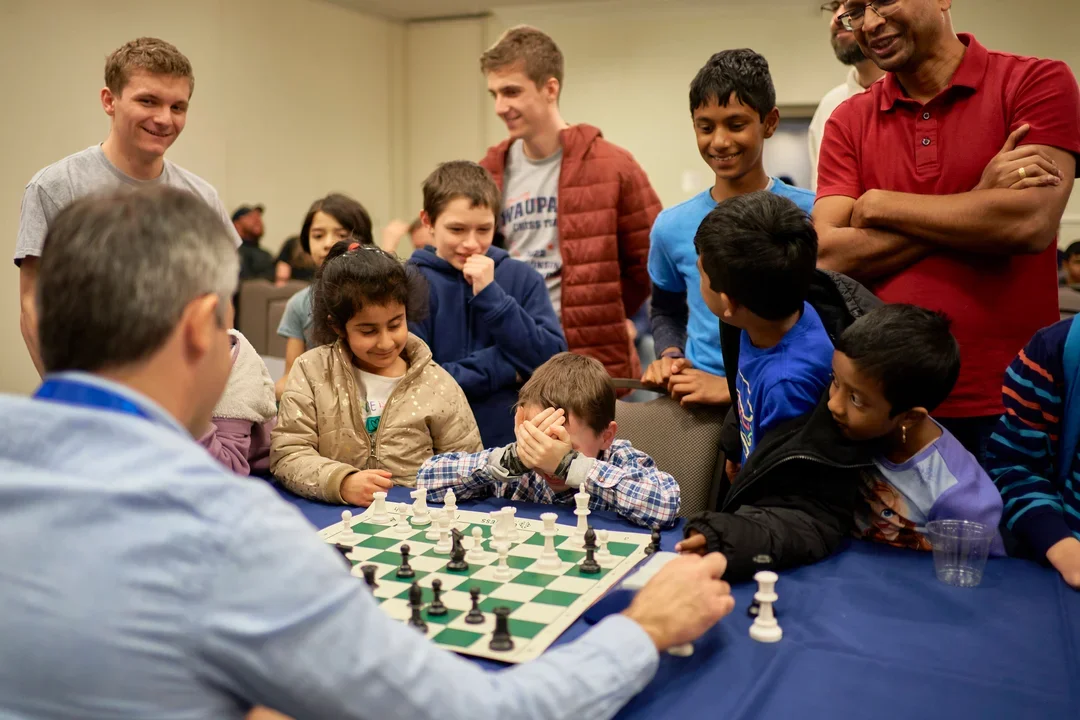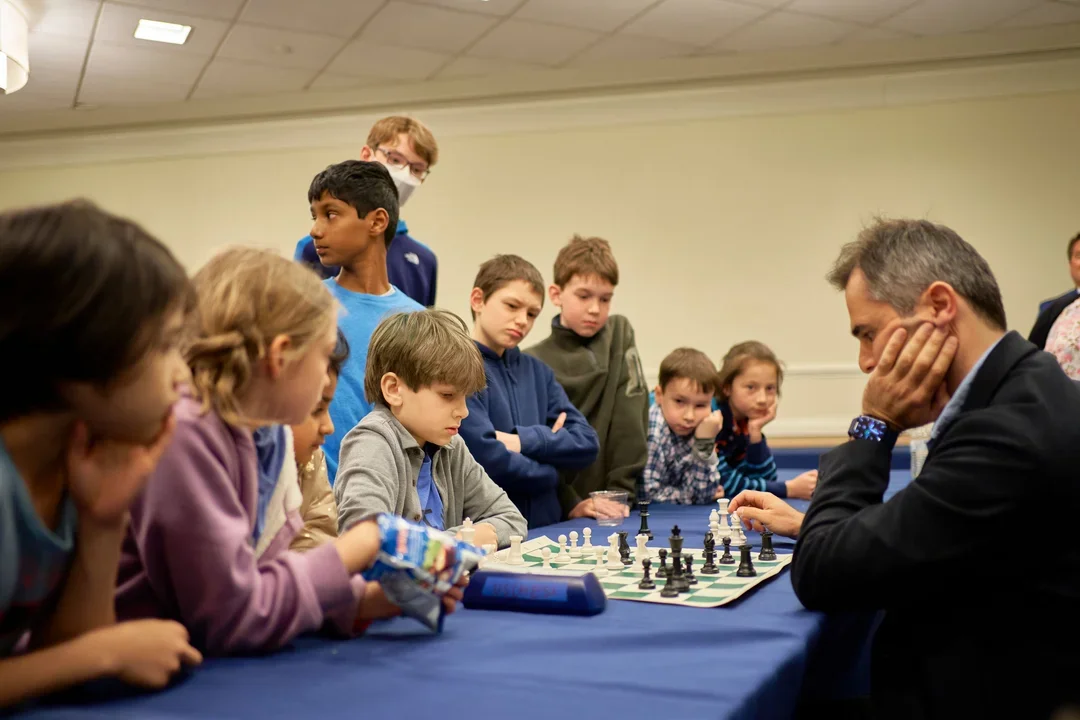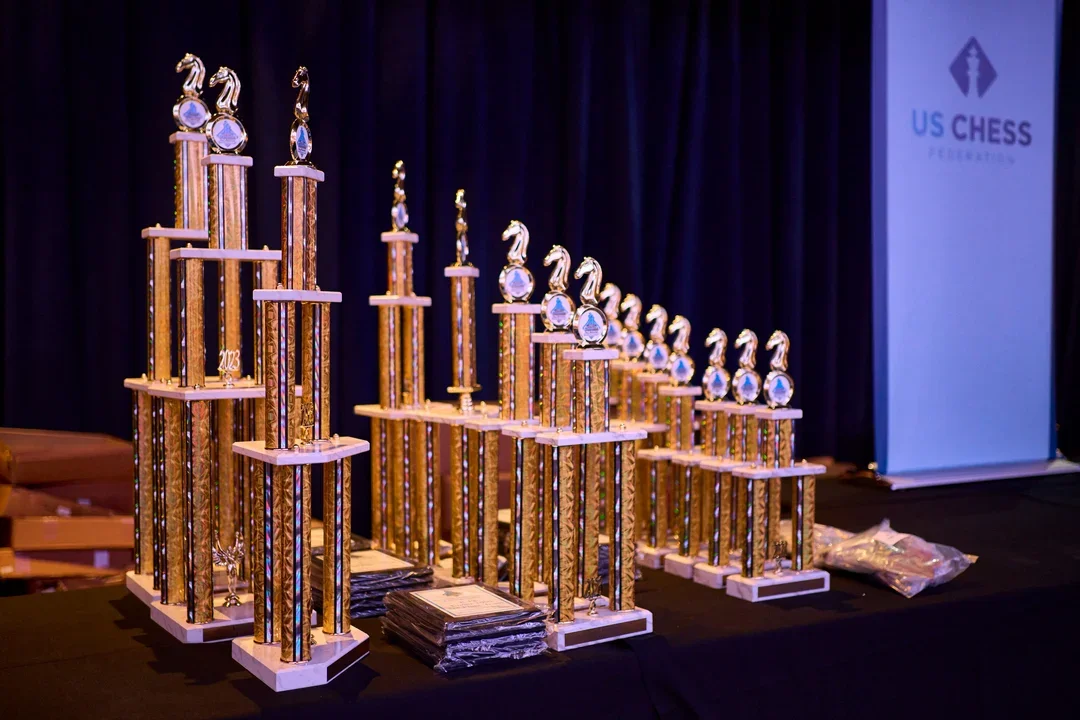
Class C Players Consistently Crush Masters in D.C.
Now that we have your attention (“April Fools'!” by the way) …
The drama and early elimination of contenders for the 2023 National High School Championships began before this event’s first move was even played!
A couple of weeks before the event, US Chess staff realized that the playing site had been overbooked by the Hilton and, as a result, a cap was placed on the number of participants in the main event (1,700 then expanded to 1,780) and in the Blitz (308). Despite the cap, a new record (unofficially 1,760) broke the previous record of 1,681 set in 2019.
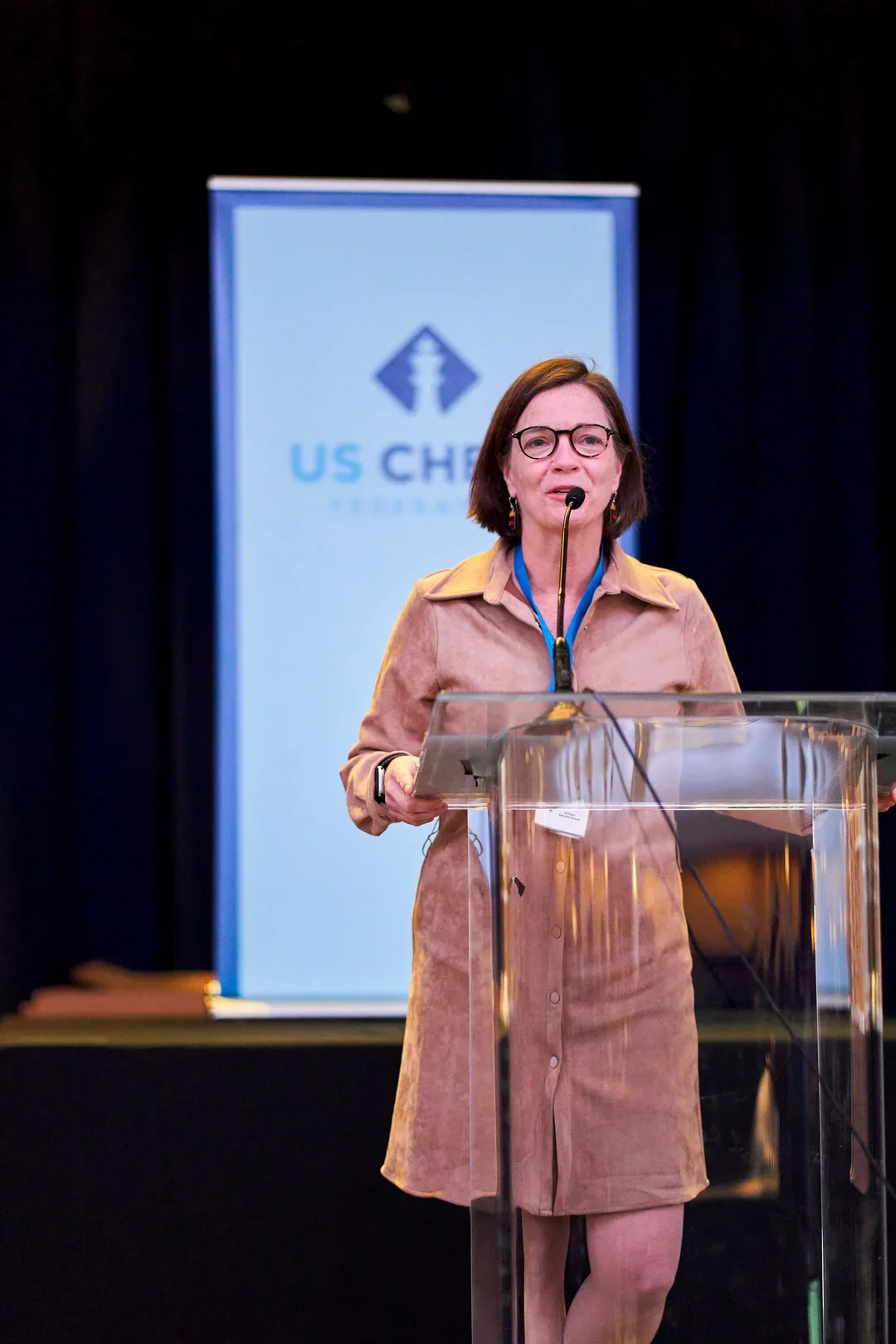
One memorable product of the overbooking was the bonus exercise that some of the Blitz players (literally led by US Chess Executive Director Carol Meyer over the Connecticut Avenue bridge) chose to engage in instead of using the shuttle service offered by US Chess to get from the site hotel (Washington D.C. Hilton) to the resourcefully obtained Omni Hotel about a mile away.
Bughouse
The only reason that Bughouse does not attract hundreds of teams is that it’s held before most teams arrive! While some coaches discourage (or downright prohibit) bughouse play right before a big event, others see it as a fun way to relax and perhaps train your eye to look for ways to create weak squares.
29 teams showed up to compete. The winning team was Kitana Olson and L. Jiang with a perfect score of 10-0! Kitana Olson chose to play in the Championship section despite having a rating of 1454, and at the time of this writing, I cannot find any record of an L. Jiang in the main event. More on this mystery tomorrow! Final standings for Bughouse here.
Blitz
When a side event venue is a mile away from the site hotel, you would expect a large percentage of late and absent players, but with the shuttle buses and aforementioned Pied Piper routine by our executive director, only the usual number of players bustled in after the scheduled start time. Maybe having a bus forced them to plan better!
After the final king was mated, the top 16 finishers of the 292 players had ratings with a “2” as the first digit (and all had four digits!). So, yes, competition was tough.
Expert Aarush Vinod (Virginia) took first on tiebreaks over co-champion IM-Elect Nico Chasin. Each scored nine wins and a draw out of the ten games (5 double-rounds in which you face each opponent twice – once with each color). Of the eight players who finished a half-point back, there were two each from Illinois, Virginia, and New York.
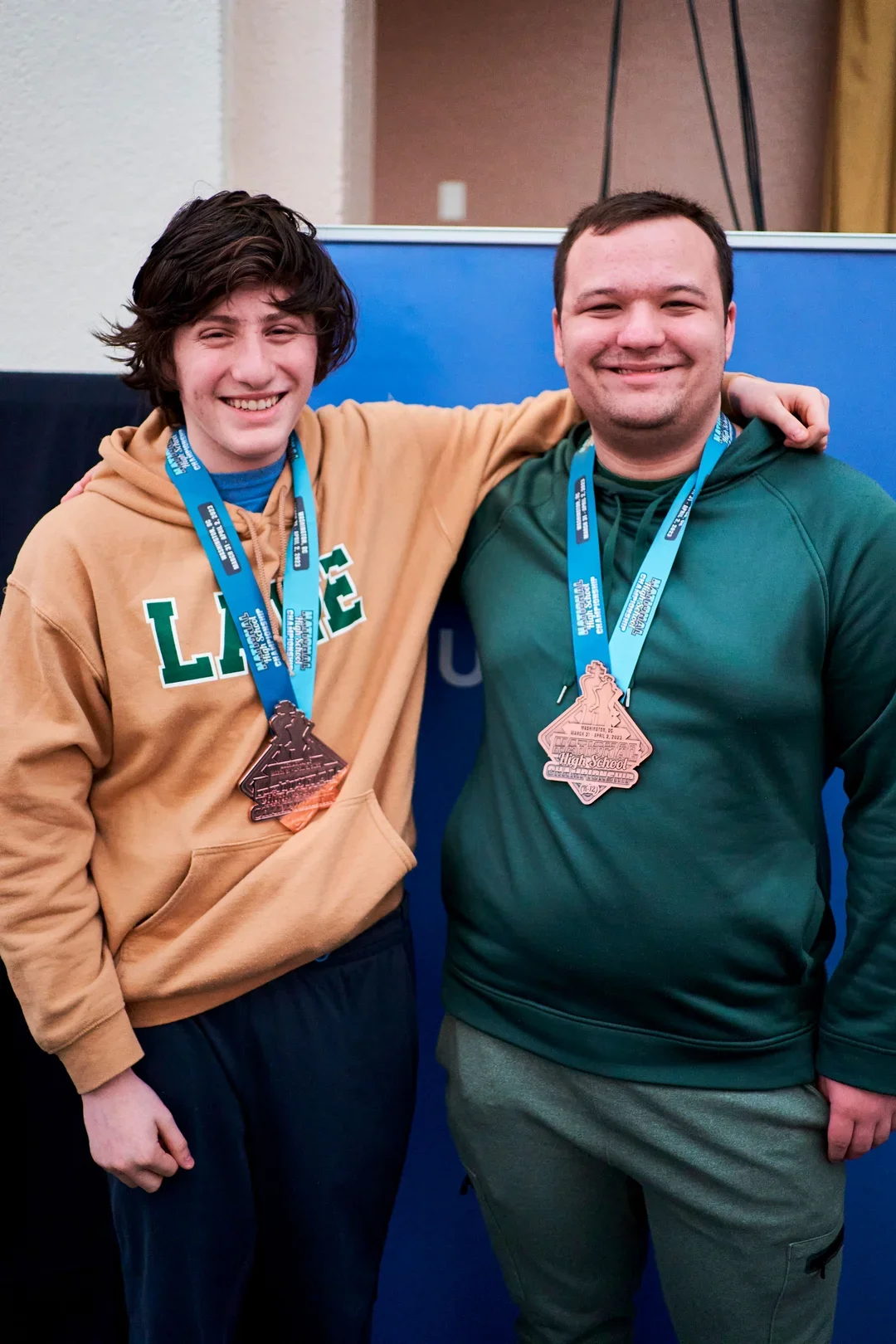
Players from Connecticut and Florida rounded out the top ten. Final standings for Blitz here.
The co-champions’ teams took the top two spots in the Blitz Team awards, but this time it was Chasin’s team that finished in first: Columbia Grammar 34½, Thomas Jefferson HS 34. The third-place team came with an interesting story…
When the current seniors at Hunter College Campus School (NY) were on a K-1 team, they took the national title. Their famed coach, FM Sunil Weeramantry, promised them that if they went to Nationals as seniors, he would make the trip with them! More on this story tomorrow!
GM Rashad Babaev Simul
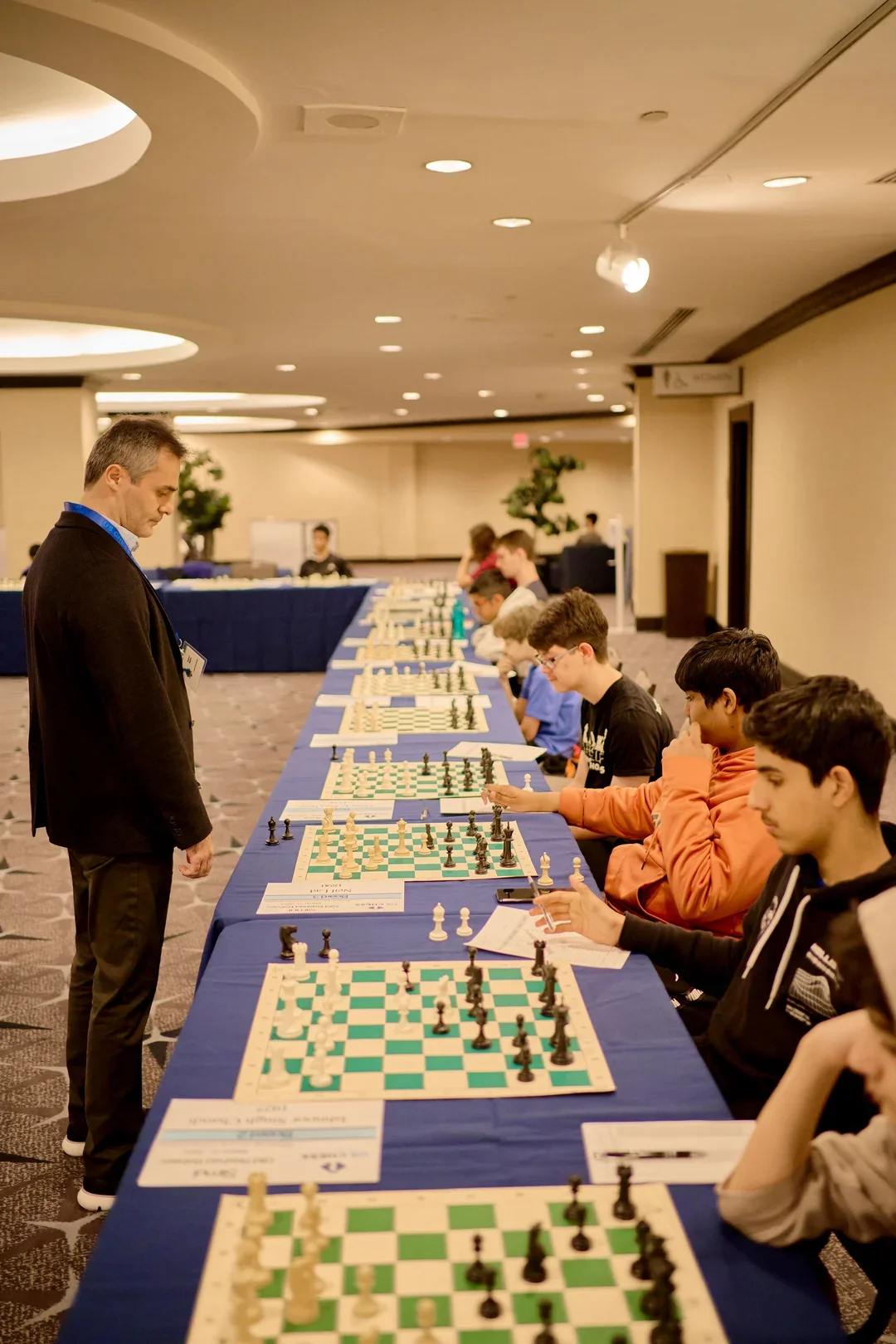
GM Babaev scored 17 wins and one draw against a tenacious group. The lone draw was earned by Aidan Baker, a fourth-grade B-player from Illinois. Nicely done, Aidan!
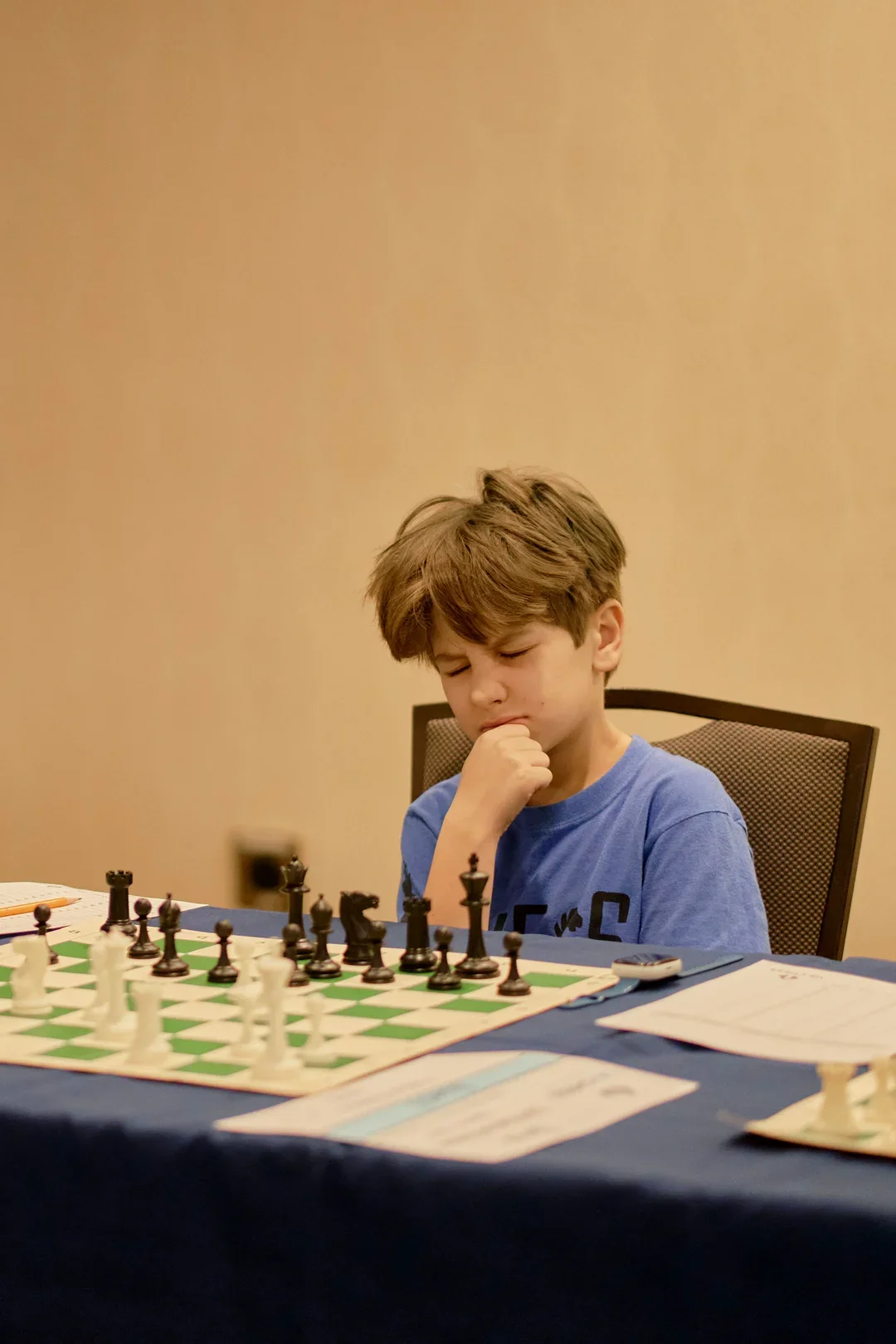
You can see his steel resolve in the face of the grandmaster's crushing attack below (and in the photo above!), and click onto the study to see a game that Babaev almost lost as well as the last game to finish.
Babaev then went on to take on all comers over the next two hours of blitz. After his lectures today and tomorrow, he will once again be open for challenges.
The Main Event
After a mere two rounds, no fewer than 48 players are still perfect in the Championship section. Worth noting is the lowest rated among them, Henry Zaslow is a senior from Illinois rated only 1465. Zaslow had upsets of about 300 and 400 points in his two wins. Very impressive, Henry!
Game of the Day: A Narrow Escape on Board Three
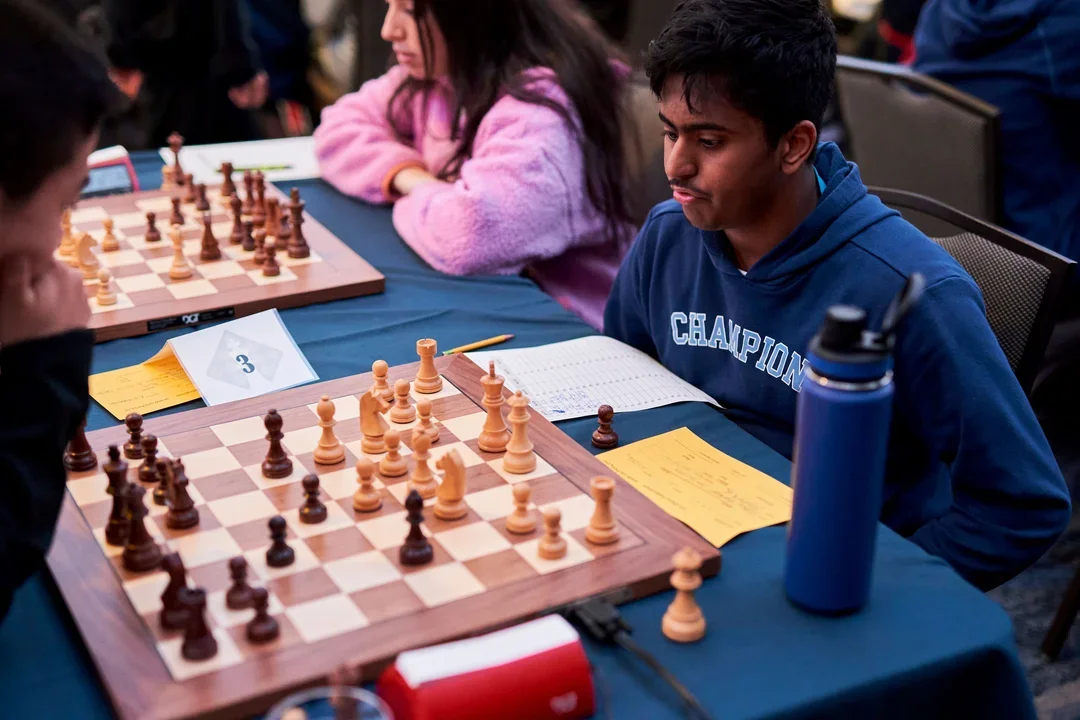
In round one, Pranav Shankar (2006, New Jersey) had FM Jason Wang (the defending North American Open champion) on the proverbial ropes in this position. Can you beat a 2500?
Precision was key, but with four seconds on the clock, the ten-second increment seemed to feel like just three seconds to Shankar and he moved quickly until finally offering a queen trade that would seal his fate.
Even in the ensuing time scramble, Shankar missed one chance to force a draw with a dangerous h-pawn.
After the game, Wang candidly admitted that he thought he was losing. In the meantime, Shankar was oblivious to the strength (2504!) of his opponent.
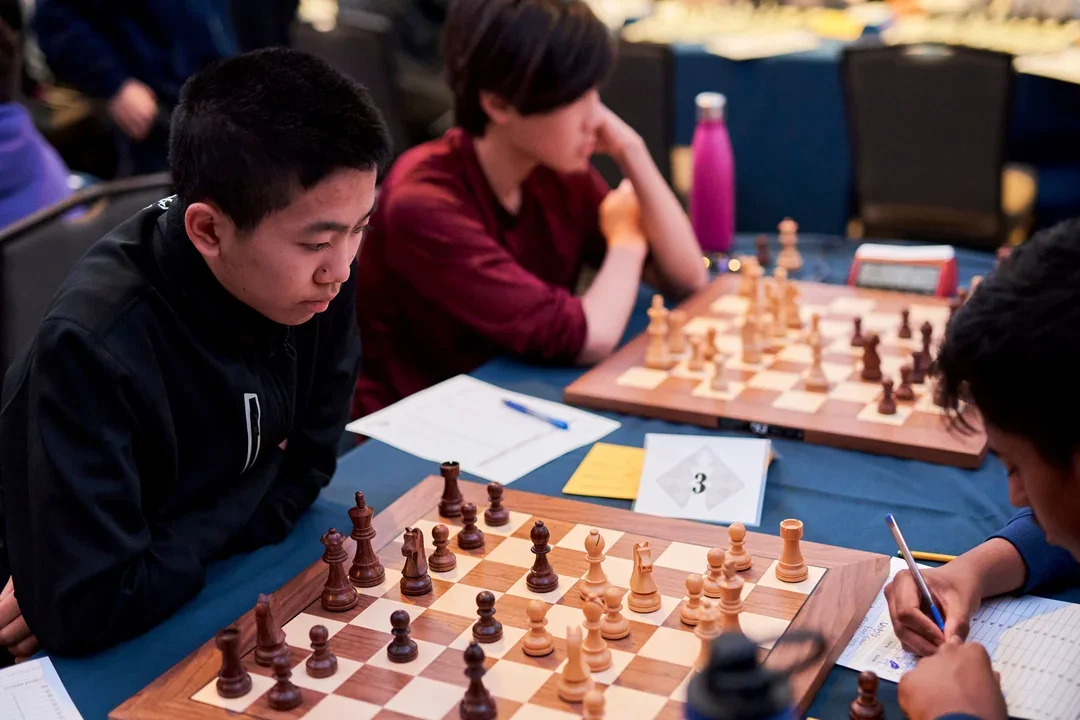
He asked Wang “Are you about 2100?” to which Wang replied “A little higher.” When I interjected (incorrectly) that Wang was 2400, Shankar almost fell over! Here's the full game:
Team Standings
First, a public service announcement: check your team listing and make sure that everyone is on it! Tournament Directors will not fix your omissions later in the tournament.
Usually, the first day is no time to talk about team standings, but it was surprising to see a team in the K-12 Championship section with three players under 1900 who joined their 2100-rated captain with a perfect score after two rounds! This Hunter team (mentioned above) needed four upsets of 200-300 points to accomplish this. And yet, it can only put them even with the mighty Dalton whose top four boards average over 2200. But, there will be much to say on the team competition over the next two days!
The Best Move of the Event? The Title I School National Event Grant
What is it?
In the words of US Chess’s Director of Development, Geoff Isaak:
“This program (the Title I School National Event Grant) is special. If you don’t believe me, just spend some time talking with some of the high school students who’ve participated in it. Their experiences go straight to the heart of our mission – they’re empowered, their lives are enriched, and they’re enhancing our communities through chess. This program is an excellent example of how chess can tangibly impact the lives of young people who just need an opportunity to play.”
Three programs received grants for this event. Each day, we will highlight a different program.
Chess in the Schools
Shaun Smith, Director of Programs at Chess in the Schools said that the sponsorships enable them to bring players who otherwise would never have this opportunity. “For more than a few of our students, they will always remember this trip as their first time on Amtrak, their first time staying in a hotel, and, perhaps most memorably, their first scholastic nationals. There’s something special about these national events that seems to really impact our players.”
Goals for the Event
“While some of the traditionally competitive schools in the Chess In the Schools program worked to place four players in each of several sections {a team score is made up of the top four players from a single school}, with hopes of top five finishes, others are here because they have impressed their coaches with their dedication and recent improvement, and we just want them to have this opportunity.” Shaun said that the process of selecting which students would attend really began in December when they started thinking about who would attend the US Amateur Team East (also called the World Teams since it is the biggest event in the U.S.).
Shaun also expressed a great appreciation for IM Dmitry Schneider who supported their programs with $50,000 in memberships and courses from Chessable, as well as GM Pascal Charbonneau who provided students with premium memberships and events from Chess24. “When the world shut down, the kids were just sitting at home and Dmitry and Pascal simply asked, 'How can we help?' That’s the chess community that we are so fortunate to have supporting us.”
Play resumes today with three more rounds, with top boards being broadcast on uschess.live.
GM Mesgen Amanov and Gopal Menon will be streaming commentary of round five at 6:00 p.m. ET on twitch.
A full schedule of events is available here.
Categories
Archives
- January 2026 (13)
- December 2025 (27)
- November 2025 (29)
- October 2025 (39)
- September 2025 (27)
- August 2025 (29)
- July 2025 (43)
- June 2025 (25)
- May 2025 (24)
- April 2025 (29)
- March 2025 (29)
- February 2025 (20)
- January 2025 (24)
- December 2024 (34)
- November 2024 (18)
- October 2024 (35)
- September 2024 (23)
- August 2024 (27)
- July 2024 (44)
- June 2024 (27)
- May 2024 (31)
- April 2024 (51)
- March 2024 (34)
- February 2024 (25)
- January 2024 (26)
- December 2023 (29)
- November 2023 (26)
- October 2023 (37)
- September 2023 (27)
- August 2023 (37)
- July 2023 (47)
- June 2023 (33)
- May 2023 (37)
- April 2023 (45)
- March 2023 (37)
- February 2023 (28)
- January 2023 (31)
- December 2022 (23)
- November 2022 (32)
- October 2022 (31)
- September 2022 (19)
- August 2022 (39)
- July 2022 (32)
- June 2022 (35)
- May 2022 (21)
- April 2022 (31)
- March 2022 (33)
- February 2022 (21)
- January 2022 (27)
- December 2021 (36)
- November 2021 (34)
- October 2021 (25)
- September 2021 (25)
- August 2021 (41)
- July 2021 (36)
- June 2021 (29)
- May 2021 (29)
- April 2021 (31)
- March 2021 (33)
- February 2021 (28)
- January 2021 (29)
- December 2020 (38)
- November 2020 (40)
- October 2020 (41)
- September 2020 (35)
- August 2020 (38)
- July 2020 (36)
- June 2020 (46)
- May 2020 (42)
- April 2020 (37)
- March 2020 (60)
- February 2020 (38)
- January 2020 (45)
- December 2019 (34)
- November 2019 (35)
- October 2019 (42)
- September 2019 (45)
- August 2019 (56)
- July 2019 (44)
- June 2019 (35)
- May 2019 (40)
- April 2019 (48)
- March 2019 (61)
- February 2019 (39)
- January 2019 (30)
- December 2018 (29)
- November 2018 (51)
- October 2018 (45)
- September 2018 (29)
- August 2018 (49)
- July 2018 (35)
- June 2018 (31)
- May 2018 (39)
- April 2018 (31)
- March 2018 (26)
- February 2018 (33)
- January 2018 (30)
- December 2017 (26)
- November 2017 (24)
- October 2017 (30)
- September 2017 (30)
- August 2017 (31)
- July 2017 (28)
- June 2017 (32)
- May 2017 (26)
- April 2017 (37)
- March 2017 (28)
- February 2017 (30)
- January 2017 (27)
- December 2016 (29)
- November 2016 (24)
- October 2016 (32)
- September 2016 (31)
- August 2016 (27)
- July 2016 (24)
- June 2016 (26)
- May 2016 (19)
- April 2016 (30)
- March 2016 (36)
- February 2016 (28)
- January 2016 (32)
- December 2015 (26)
- November 2015 (23)
- October 2015 (16)
- September 2015 (28)
- August 2015 (28)
- July 2015 (6)
- June 2015 (1)
- May 2015 (2)
- April 2015 (1)
- February 2015 (3)
- January 2015 (1)
- December 2014 (1)
- July 2010 (1)
- October 1991 (1)
- August 1989 (1)
- January 1988 (1)
- December 1983 (1)


